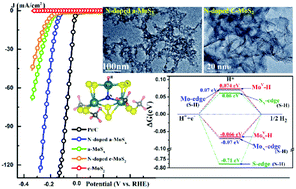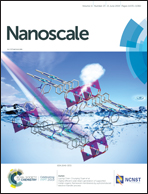N-Doped amorphous MoSx for the hydrogen evolution reaction†
Abstract
Herein, the functions of a N dopant in crystalline MoS2 catalysts during the electrochemical hydrogen evolution reaction (HER) were reported via a combined experimental and first-principles approach. However, studies on the N doping of amorphous MoSx, which is a more active catalyst, have not been reported to date. In this study, via a simple method, we fabricated N-doped amorphous MoSx for the first time and studied the correlations between the N dopant and the HER performance. Via X-ray photoelectron spectroscopy and theoretical formation energy calculations, we have found that a N dopant in basal plane S2− plays a very important role in the improvement of the HER performance and remains stable during this dynamic transformation process. A N dopant in basal plane S2− can increase the number of active sites toward the HER and enhance the conductivity of the catalysts as well as a N dopant in c-MoS2. In addition to this, the first-principles calculations further suggested that a N dopant in basal plane S2− could improve the activity of unsaturated MoV active sites by bringing its hydrogen adsorption free energy closer to zero. As a result, N-doped amorphous MoSx possesses an overpotential of 143 mV at 10 mA cm−2 and a Tafel slope of 57 mV dec−1, much better than those of a-MoSx. These results provide useful insights for the future development of nonmetal-doped MoSx catalysts in the HER.



 Please wait while we load your content...
Please wait while we load your content...